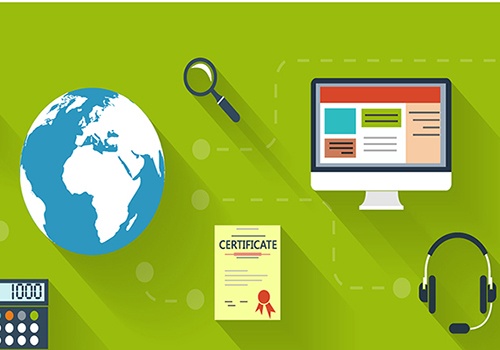Modern Learning Environments: How Learning Has Changed Forever
There was once a time when you learned primarily while sitting in a room, listening to a lecture, and perusing assigned readings in paper textbooks. Now, in modern learning environments, the information and skill-acquisition paradigm has evolved to incorporate technology, and a plethora of knowledge sources can leave learners feeling overwhelmed. Add to that the instant nature of Google searches and the multitude of ads that accompany them, and the result is knowledge-driven consumers who struggle with patience and focus. Reaching the modern learner requires an understanding of how they interact with the world and their preferred avenues for accessing information.
1. Desktop eLearning Isn’t The Only Way: People Want To Learn Using Multiple Devices

Personal electronic devices are ubiquitous information-accessing tools, and their numbers are growing. If you have a device in your household, chances are that you have a second or third as well. Studies cite that the use of two devices per day accounts for 63 percent of the online adult population in the United States and United Kingdom. The number of those who use a third device per day is still a robust 20 percent. Even more significant is the tendency for users to employ multiple devices for related purposes, such as acquiring information by reading text or watching a video with a cell phone and then demonstrating that knowledge via eLearning on a desktop computer. Learning professionals must make their content compatible across devices without disregarding the impact of the smartphone.
Related: Why mobile learning is important (4 reasons)
2. People Are Ignoring Books And Learning From Smartphones

Smartphones are an enormous boon to learning, given the fact that they incorporate multiple tools to facilitate information gathering. A book only provides written information and illustrations. A video player simply allows you to view filmed content. A trainer can give oral instructions, answer questions, and manage discussions. A library houses reference material. On the other hand, a smartphone alone does all of these things and more. Add to the list the smartphone’s capabilities of video recording, GPS integration, and app use, and you have an educational tool that has as much potential as its user can envision.
In fact, smartphones are so convenient that 70 percent of modern learners use them to learn. Statistics from 2015 show that more than 80 percent of U.S. adults aged 18 to 49 use smartphones for all kinds of purposes. Touchscreen mobile devices are increasing in number, and the market for devices that stay home (such as desktop computers) is staying stable. In spite of these mobile-friendly numbers, only 12 percent of corporate education is mobile-compatible, leaving a void that needs bridging by learning technology. You need more designs with modern learning needs in mind, incorporating factors such as when and where learning happens.
3. People Are Learning In Different Ways, Mostly At The Point Of Need

Learning occurs at variable times. It’s a multi-situational experience for the modern learner. The largest amount (52 percent) of learning occurs at the point of need, or when the learner requires missing information. They often seek out the necessary information through a Google search on a cell phone, for example. The next common learning scenario comes during evenings and weekends, which is when 47 percent of learners acquire new information. This number surpasses the amount of learning that employees do while on the job, which is just 42 percent. You can see from this number that information seekers might not be getting what they need from limited systems such as intranets or company-based Learning Management Systems. Further illustrating this point is that a significant 27 percent of people do learning during their commute, both before they arrive at the office and after they leave.
4. People Prefer Self-Paced Learning, So Search Engines Are Popular

Since the point of need represents the highest occurrence of learning, it follows that search engine queries are the most useful method for promoting that learning. The speed at which one can arrive at the required answer or solution using an internet search is the key to its appeal. Collaboration and self-paced, manager-supported online courses also rank highly in the eyes of the learner in the modern learning environment. Job aids and online performance tools are valuable as well. Interestingly, the passive and time-consuming method of video and podcast consumption ranks low to the impatient modern learner. It appeals to a mere 40 percent of learners, in contrast to the 80 percent who favor quick online searches.
5. People Want Quality Information, But Also Value Speed And Convenience

In an era where speed and convenience are high priorities for knowledge acquisition, the quality of the information received still tops the list of what really matters; therefore, 76 percent of learners select the quality of their learning as being most important. Learners in the modern learning environment also appreciate timeliness, relevance, and identifiable objectives. Additionally, people want to build their personal credentials. For example, 57 percent affirm that they want to be able to increase their professional development through additional certifications and qualifications.
6. People Are Prioritizing (And Paying For) Their Own Professional Development

Those self-driven learners who prioritize professional development are likely to take responsibility for paying for their training and education outside of work. Lynda.com is an avenue to do just that, and it lists several areas of study that are popular and related to computer technology, leadership, project management, and finances.
Final Thoughts
Learners in modern learning environments are independent and ambitious, taking initiative and learning across various settings while incorporating multiple forms of technology. They want a flexible learning schedule and the expedited access to learning that their devices provide. Elucidat's authoring platform can help your organization create quality multi-device learning content to capture and hold the attention of the modern learner. Are you taking all the steps you can to ensure that your company connects with this new generation of ambitious consumers of knowledge?
Next step: Read our article; Why Modern Learners Want The Convenience And Flexibility Of Mobile Learning






![Outgrowing Your LMS? 5 Ways Modern Learning Is Rewriting The Rules Of The LMS [eBook Launch]](https://cdn.elearningindustry.com/wp-content/uploads/2022/11/Shutterstock_345947564-1.jpg)


